Browse in the Library:
Search Posts by Categories:
Herbie Hancock: An Analysis of His Improvisional Style (2/3)
Outside Triplet Sequences on “All of You”
The following examples are from one of Hancock’s greatest recorded solos61 on Cole Porter’s “All of You”. On this particular recording, Hancock plays two complete choruses and then solos over a long “tag” section of iii-VI-ii-V changes in Eb (Gm7, C7, Fm7, Bb7). A few bars into this tag section, Hancock starts to spin triplet sequence after triplet sequence, creating long flowing lines of increasing and decreasing tension. Most of these sequences are based on simple two to four note scalar patterns which weave craftily through (and occasionally outside) the changes.

In Figure 2.29, Hancock starts with a simple three note motif and sequences it upwards. He strays “outside” in beat 3 of bar 4 of this extract, playing an E major triad over the C7 (E major contains a Bnatural – the major seventh of C instead of the flattened or dominant seventh implied by the chord symbol). The clash is not overly offensive or dissonant to the ear due to the strength of the sequenced line in the previous bars.

Later in the same solo, Hancock plays Figure 2.30 above. This extract contains multiple examples of sequences – this time Hancock starts with a simple two-note triplet pattern which he develops and uses to get outside the changes from beat 4 of bar 2. This ascends into the same type of four-note triplet pattern seen in previous examples, which gradually sequences its way down again.
Once again, Hancock strays outside in the final bar of the extract. Shortly afterwards, Hancock plays Figure 2.31, again making use of a four-note pattern and again using it to get outside the changes in bar 3.

Hancock then plays:

Here, he starts with a three-note triplet pattern and again uses this concept to get outside the changes in bar 3. The example ends with simple melodic sequence of the type discussed in the previous section – the initial phrase is exactly transposed down a semitone. The type of block chords seen at the end of this example is strongly reminiscent of the technique popularized by pianist Red Garland – Miles Davis’ pianist from the previous decade.
Extended Outside Triplet Sequences
Most of the previous examples demonstrate Hancock playing “outside” for only short periods of time, before bringing a melody back in line with the chord changes. However, Hancock will also often spin long, often highly chromatic triplet sequences in which he seemingly disregards the underlying chord changes for an extended length of time.
At the start of his second chorus on Wayne Shorter’s “Witch Hunt”, Hancock begins to spin a lengthy triplet sequence, using the intervals of a minor second and a fourth to dance in and out of the stagnant harmony of Cm7. This is particularly obvious in the final three bars of the figure, which contains one consistently descending line based on falling and rising fourths and semitones.

Hancock uses this same technique again as a sideman in Miles Davis’ quintet – this time he picks up on a triplet figure played by Tony Williams in the last few bars of Hancock’s first chorus, and uses this as a springboard into another long and highly chromatic phrase (see Figure 2.33).
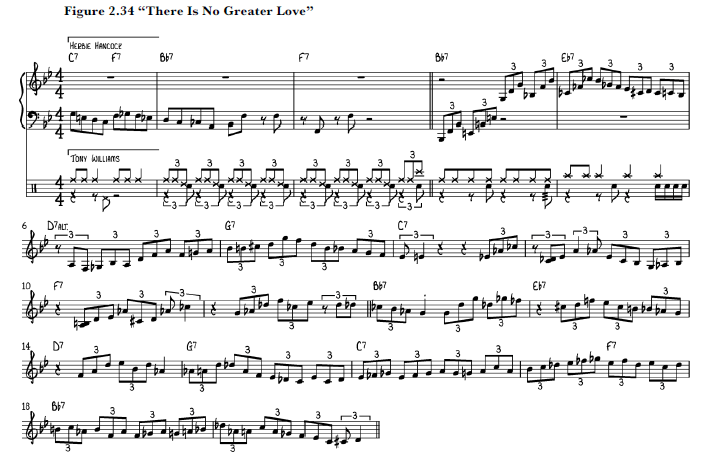
While not strictly exact melodic sequences, both of the previous examples are long rhythmic sequences and contain several distinct examples of sequenced melodic material – for example bars 3&4 and 7&8 of Figure 2.33 and bars 4 and 8&9 of Figure 2.34.
Motif Development
One of the qualities of a great improviser is the ability to develop and extend their melodic ideas. Similar to sequences, motivic development often involves repetition of an initial phrase which is subsequently built on in the following bars – a technique which adds a sense of logical structure to the solo. Hancock is a master at developing his motifs, which often stem from fairly simple starting phrases.

Figure 2.35 is an example of this. Hancock starts out with a simple one note rhythmic idea and gradually adds further notes to develop the phrase, while still maintaining the original F as a tonal center.

In the above example, Hancock takes a simple Gm7 arpeggio and repeats it over the course of 4 bars, creating beautiful melodic continuity through the harmony.
Figure 2.37 on the following page is another example of motivic development – Hancock picks up on a melodic idea played by Miles Davis at the end of his solo and repeats it, maintaining the rhythm and contour but initially sequencing it up minor third.

Similarly, in Figure 2.38, Hancock picks up on a three note phrase played by trumpeter Freddie Hubbard, sequences it upwards for 6 bars before using it to springboard into the start of his second solo on the alternate take of “One Finger Snap”. An interesting point of focus in the first line is that the semibreves at the end of each phrase in bar 4, 6 and 8 are an exact retrograde of the initial phrase Hancock plays in bar 3. The final two bars of this extract also demonstrate another sequence, a pattern of an ascending semitone and a fourth which climbs up chromatically.

In Figure 2.39, Hancock begins with a simple melodic motif, which he develops through the subsequent 11 bars.
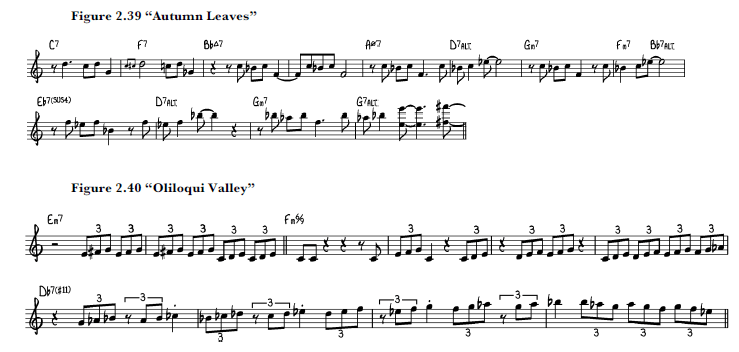
In Figure 2.40, Hancock starts with a triplet motif of notes grouped in threes, which is then sequenced down a third. He then continues to develop this idea in the subsequent measures by continuing the same three note-triplet theme while ascending through the associated scales of each chord (F melodic minor and Db Lydian dominant). This sort of development is an extremely effective way of building tension in a melodic line.

Again in Figure 2.41, Hancock starts with a simple three note motif which gradually sequences upwards, before descending, again through the use of sequence. He then continues the motif into the third line of the example, and begins to imply a 3 over 4 cross rhythm in the last four bars – the final
phrase starting in bar 3 of the third line repeats every 3 beats.

Here, Hancock starts with a six note motif which he sequences down twice in the subsequent bars, before using the idea as a springboard into the next chorus of his solo. Of particular note here is Hancock’s extended use of chromaticism over the Ebmaj7 chord – he avoids landing on guide tones on the strong beats of the bar, which helps to propel the melodic line forward to its resolution at the start of the next chorus.
Rhythmic Elements/Technical Virtuosity
The title of this section refers more specifically to rhythmic devices used by Hancock – with a focus on phrases that display his remarkable technical facility.
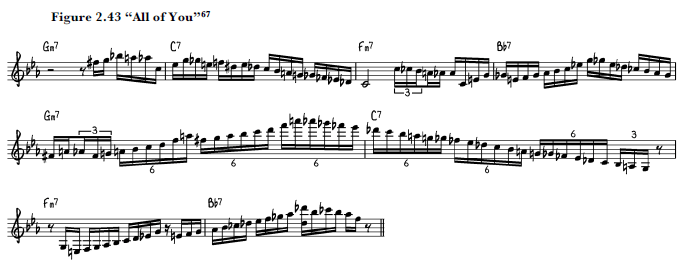
This extract from Hancock’s solo on “All of You” demonstrates his facility with double time.
Here Hancock dances around the changes in scalar patterns, making extensive use of diminished and altered scales to modify the standard harmony while utilizing both semiquavers and semiquaver-triplets.
Figure 2.44 is an extract from Hancock’s solo on “Circle”, a tune from Miles Davis’ album Miles Smiles (1966). In this example, Hancock executes another long passage of triplets and uses a triadic motif to quickly extend the phrase through 4 octaves.
There a few areas of particular interest here: the first is Hancock begins the D major triadic motif in bar 5 of the figure and continues it through the Bbmaj7 in bar 7, reharmonizing the chord to Bbmaj7(#5). The second is the beat that is dropped at the start of the third line of the figure – the rhythm section adjusts immediately to the 2/4 bar, showing the group’s uncanny rapport and adaptation in support of the soloist. Hancock also finishes the long passage of triplets with another simple, scalar melodic sequence.
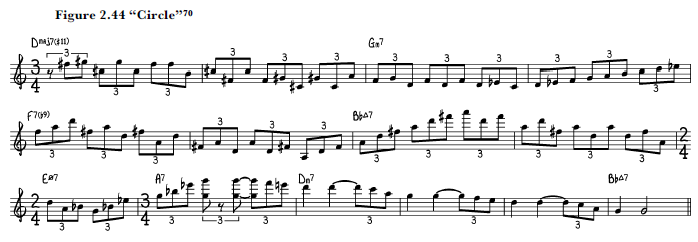
Hancock also makes use of complicated rhythmic denominations, as seen in Figure 2.45 below. This example is taken from Hancock’s solo on “The Egg”, a compositional sketch in which the only stipulations are an initial piano ostinato and a melodic line played by the trumpet, before the piece descends into open, free improvisation.

Miscellaneous Signature Characteristics
Hancock also has several idiosyncratic phrases which he uses in a variety of different settings. The first of these is Hancock’s signature blues lick:

This phrase, unique to Hancock, makes an appearance early his recorded output and continues to show up in various manifestations and situations into the late 60s – despite the juxtaposition between the phrase’s fairly blues orientated nature and the more contemporary vein of the music during that period (see Figure 2.47).
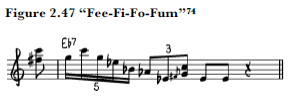
Another signature characteristic of Hancock’s is his tendency to play his melodic lines in octaves. This either occurs in the middle of a phrase:

Or at the start of a phrase and continuing for an extended period:

In summary, Hancock’s melodic lines contain a range of signature characteristics, which contain devices that reflect both the wider jazz language and also Hancock’s unique approach to melodic line construction. While all the previous examples were examined taxonomically, Chapter 3 examines them within the context of a single solo.
This analysis argues is that through the use of a range of signature characteristics, Herbie Hancock emerged in the early 1960s as a truly original artist. Drawing upon and the building on the developments made by his predecessors, Hancock was ones of small group of artists who brought jazz into the modern era, by demonstrating both strong command of the traditional jazz language and a powerfully explorative, individual voice.
Best site for Jazz sheet music download is right here.
Herbie Hancock – Maiden Voyage (Full Album)
Personnel:
Herbie Hancock — piano
Freddie Hubbard — trumpet
George Coleman.
Track List:
1: maiden voyage 2: The Eye of the Hurricane 3: Little One 4: Survival of the Fittest 5: Dolphin Dance
References
Berliner, P. F. (1994). Thinking in Jazz: The Infinite Art of Improvisation. Chicago: The University of Chicago Press, Ltd.
Blumenthal, B. (2000). Pianists of the 1960s and 1970s. The Oxford Companion to Jazz, 466-467.
Cambridge Dictionaries Online. Taxonomy. Retrieved 31 May, 2011
Coker, J. (1991). Elements of the Jazz Language for the Developing Improvisor. Miami: Belwin, Inc.
Coolman, T. F. (1997). The Miles Davis Quintet of the mid-1960’s: Synthesis of Improvisational and Compositional
Elements. New York University.
Coolman, T. F. (2006). Herbie Hancock & the Miles Davis Rhythm Section. Piano Today(26.1), 30-31.
Davis, M., & Troupe, Q. (1989). Miles – The Autobiography. New York: Simon & Schuster.
DiMartino, D. (1999). Herbie Hancock : He Continues to Lead Where Most Other Artists Are Content to Follow. Billboard – The International Newsweekly of Music, Video and Home Entertainment, 111, 2-12.
Dobbins, B. (1992). Herbie Hancock Classic Jazz Compositions and Piano Solos. Rottenberg: Advance Music.
Gelfand, A. (2005). Almost Anything Goes: For Herbie Hancock, Jazz is All About Freedom and Personal Expression. JAZZIZ, 22, 36-38.
Heinrich, D. (2006). Jimmy Smith and Larry Young – Blue Note Records’ Jazz Organ Masters: A Comparison of Style. Unpublished honours thesis, Sydney Conservatorium of Music.
Johnson-Laird, P. N. (2002). How Jazz Musicians Improvise. Music Perception: An Interdisciplinary Journal, 19(3).
Kart, L. (2000). The Avant-Garde, 1949-1967. The Oxford Companion to Jazz, 446-458.
Levin, E. (1987, January 19). Herbie Hancock. People, 27, 64.
Levine, M. (1989). The Jazz Piano Book. Petaluma, CA.: Sher Music Co.
Levine, M. (1995). The Jazz Theory Book. Petaluma, CA.: Sher Music Co.
Opstad, J. (2009). The Harmonic and Rhythmic Language of Herbie Hancock’s 1970s Fender Rhodes
Solos. Jazz Perspectives, 3(1), 57-79.
Perry, J. C. (2006). A comparative analysis of selected piano solos by Red Garland, Bill Evans, Wynton Kelly and Herbie Hancock from their recordings with the Miles Davis groups, 1955–1968. University of Miami.
Pond, S. F. (2005). Head Hunters: The Making of Jazz’s First Platinum Album: University of Michigan Press.
Rose, J. (2006). White Light, Black Vibrations: The Music of John Coltrane and his Spiritual Quest. Unpublished honours thesis, Sydney Conservatorium of Music.
Sawyer, R. K. (2000). Improvisation and the Creative Process: Dewey, Collingwood, and the Aesthetics of Spontaneity. The Journal of Aesthetics and Art Criticism, 58(2), 149-161.
Seymour, G. (2000). Hard Bop. The Oxford Companion to Jazz, 373-388.
Silvert, C. (September 8, 1977). Herbie Hancock: Revamping the Past, Creating the Future. Down Beat, 16.
Szwed, J. (2002). So What: The Life of Miles Davis. New York: Simon & Schuster.
Thompson, S., & Lehmann, A. C. (2004). Strategies for Sight Reading and Improvising Music. New York: Oxford University Press.
Wallmann, J. P. (2010). The Music of Herbie Hancock: Composition and Improvisation in the Blue Note years. New York University.
Waters, K. (2005). Modes, Scales, Functional Harmony, and Nonfunctional Harmony in the Compositions of Herbie Hancock. Journal of Music Theory, 49(No. 2), 333-357.
Waters, K. (2011). The Studio Recordings of the Miles Davis Quintet, 1965-1968. New York: Oxford University Press.
Widenhofer, S. B. (1988). Bill Evans: An Analytical Study of His Improvisational Style Through Selected Transcriptions. University of Northern Colorado.
Woodard, J. (1997). Hancock and Shorter: Two Divided By One. JazzTimes – America’s Jazz Magazine, 27, 44-47, 57, 144-145.
